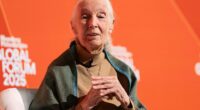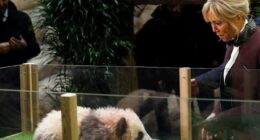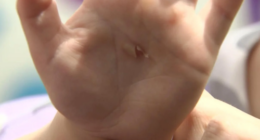Share this @internewscast.com
World renowned primatologist Jane Goodall has died at the age of 91 during her tour of the US.
The renowned conservationist gained fame for her pioneering work with chimpanzees, which commenced when she journeyed to Tanzania’s Gombe Stream National Park in 1960.
In 1977, she established the Jane Goodall Institute to further research in Gombe park. This organization focuses on species protection and supports youth projects that benefit wildlife and the environment.
Dr. Goodall passed away due to natural causes while visiting California during her US speaking tour, the Jane Goodall Institute announced on Facebook.
The post stated, ‘The Jane Goodall Institute learned this morning, Wednesday 1 October 2025, that Dr. Jane Goodall DBE, UN Messenger of Peace and Founder of the Jane Goodall Institute, has passed away from natural causes.’
‘She was in California as part of her speaking tour in the United States.
‘Dr. Goodall’s achievements in ethology revolutionized science, and she was an unwavering advocate for conserving and revitalizing the natural world.’

Primatologist Jane Goodall has died of natural causes at the age of 91. She is pictured during a talk in New York last Wednesday

Goodall (pictured) was widely considered the world’s leading expert on chimpanzees
Born in 1934 in London, Goodall was raised in middle-class Bournemouth, where she recalled that as a youngster, the notion of her becoming a scientist was nearly unimaginable.
‘There was no thought of becoming a scientist because girls weren’t scientists in those days. And actually there weren’t really any men going out there living in the wild.’
So Goodall drew her inspiration from fiction and she developed two great passions: animals and Africa.
Goodall also credited her mother, novelist Margaret Myfanwe Joseph, with encouraging her to pursue a career in the male-dominated field of primatology.
‘I got my love of animals from the Dr Dolittle books and my love of Africa from the Tarzan novels,’ she said 2019. ‘I remember my mum taking me to the first Tarzan film and bursting into tears.’
Dr Goodall was just 26-years-old when she travelled to what is now Tanzania with little more than a notebook and a pair of binoculars.
Goodall set out to meet the creatures she loved and this began 60 years of ground-breaking work to save them from extinction.
Going on to be a full-time primatologist and anthropologist she is considered one of the world’s leading experts on chimpanzees.
Goodall’s early love of primates developed after her father gave her a toy chimpanzee named Jubilee as a young girl instead of a teddy bear.

Conservationist Jane Goodall is presented with the Presidential Medal of Freedom, the Nation’s highest civilian honor, by former President Joe Biden in January 2025
Goodall went to Uplands School, an independent school in Poole. She left in 1952 but couldn’t afford to go to university, so she worked as a secretary at Oxford University for a few years.
In May 1956, her friend Clo Mange invited Goodall to her family’s farm in the Kenyan highlights. Mange encouraged her to contact Louis Leaky, the notable archaeologist and palaeontologist and she began working as his secretary at age 23.
Goodall went to Gombe National Park in 1960 to study chimpanzees, while Leakey chose two other female researchers, Dian Fossey and Birute Galdikas, to study gorillas and orangutans.
The three became known as The Trimates or Leakey’s Angels. At Gombe, Jane withstood all manner of natural threats: malaria, parasites, snakes, storms.
In 1962 Leakey arranged funding for Goodall to go to Cambridge University to study for a PhD.
She was only the eighth person in history to attend the university without a previous qualification, and in 2020 she said this was her proudest achievement.
Leakey thought that Goodall would make a perfect researcher ‘with a mind uncluttered and unbiased by theory’.
This unorthodox approach to primatology became the key to her success. Instead of numbering the chimpanzees she studied, she gave them affectionate names such as Fifi and David Greybeard.
She noticed their unique and individual personalities, an unconventional idea at the time, finding that ‘it isn’t only human beings who have personality, who are capable of rational thought and emotions like joy and sorrow’.
She also observed behaviour such as hugs, kisses and even tickling. Her work held up a mirror to our own species, suggesting many human behaviours, once thought to be unique, may have been inherited from our ancestors.
Setting herself apart from other researchers also led her to develop a close bond with the chimpanzees and to become, to this day, the only human ever accepted into chimpanzee society.





